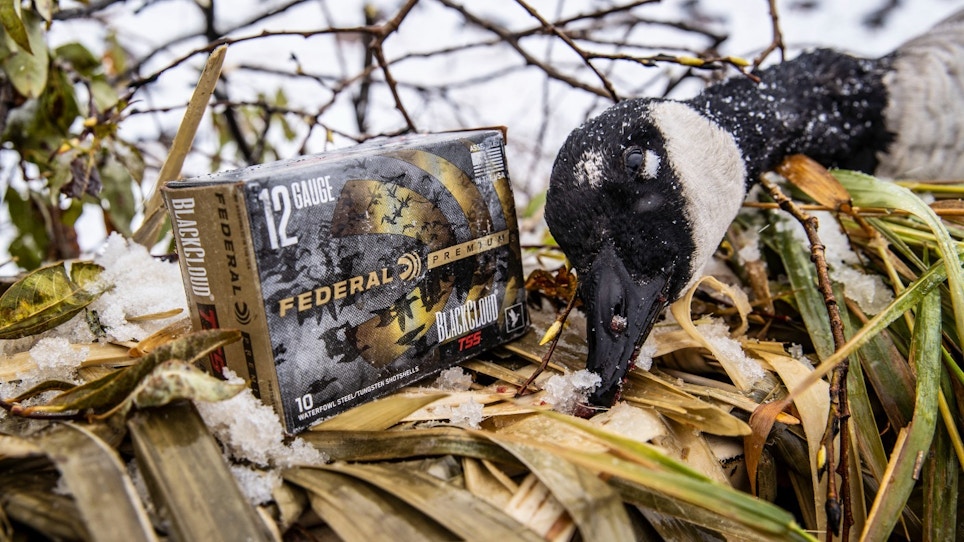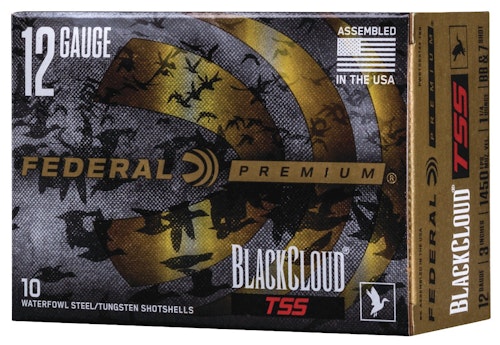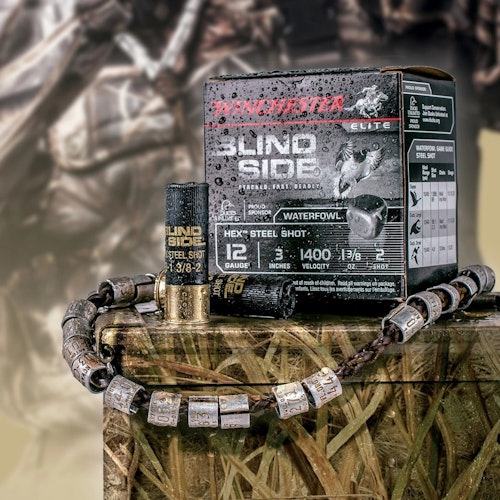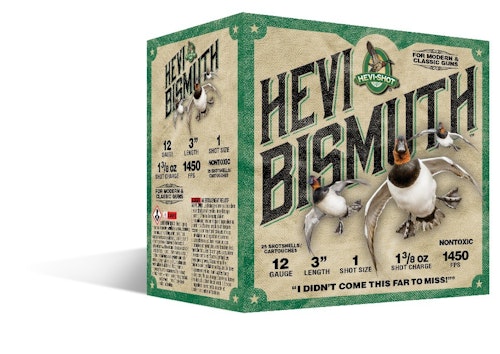Waterfowl hunters are a strange breed. They’re stalwart folks willing to get up hours before dawn in the worst of weather, make a long drive to a lake or marsh, take an uncomfortable walk or boat ride in the pitch darkness and set out their decoys in water barely warm enough to still be liquid. Then, they’ll sit for hours in the frigid cold with high winds ripping past just waiting for a shot at their favorite quarry.
In truth, most waterfowl hunters are so addicted to their favorite sport that they’re not likely to skimp on many items when it comes to gear. And ammunition is one place you’ll seldom see them looking for the cheapest box of shells to take to the blind for the coming weekend’s hunt.
That’s because some waterfowl shells are much more effective at taking ducks and geese — really killing them dead, not just dropping them — than others. Anyone who was hunting ducks a little more than 30 years ago, when the U.S. Fish & Wildlife Service implemented a nontoxic regulation for waterfowl shells, knows exactly what I mean.
I recall a hunt back in the fall of 1991. I was at my favorite mallard honeyhole in southwestern Oklahoma, where a limit was more common than being skunked. However, the federal government had just made a new law requiring nontoxic shot for waterfowl, and the steel shot that was on the market was less than effective. Birds I had been killing dead with lead No. 6s were flying away as though they hadn’t been touched.
Of course, that was then, and this is now. Thankfully, over the next handful of years, manufacturers began making better and better steel shotshells, and hunters learned more about proper patterning, choke tubes and use of the ammunition. But another thing happened, also. The poor quality and less-than-optimal killing power of the early steel loads led to companies looking for other nontoxic alternatives. Additionally, many hunters still wanted to use their trusty old duck gun, but some older barrels wouldn’t handle steel loads. The result was a variety of loads that were more effective than steel, but often at a much higher price tag.
While some have come and gone over the past three decades, many are here to stay. And some use even better shot materials than ever before! Let’s take a look at three waterfowl loads that will keep your duck- and goose-hunting customers happy and coming back for more.
Federal Black Cloud TSS Waterfowl
Tungsten Super Shot (TSS) is all the rage nowadays, and there’s little wonder why — it kills ducks effectively at longer distances than many other waterfowl shot alternatives. That’s because it has a 56% higher density than lead and more than double the density of steel.
Consequently, TSS pellets maintain velocity at greater range, hit harder and penetrate deeper than many other waterfowl shot types.
Black Cloud TSS carries on a lethal legacy, blending proven Flitestopper Steel pellets and 18 Tungsten Super Shot. With a payload of 60% TSS pellets and 40% steel of different sizes, it’s a lethal combination out to 50 yards. For instance, one 3-inch 12-gauge load combines 1 1/4 ounces of No. 7 or 9 TSS with BB or No. 3 steel, all packed in the company’s proven Flightcontrol Flexwad. That combination results in a muzzle velocity of about 1,450 feet per second (fps).
Plus, Black Cloud TSS is available in 20-gauge loads, allowing those who enjoy sub-gauge waterfowl hunting to also have some top-quality ammunition to choose from. The 20-gauge shell uses 1 ounce of blended No. 3 steel and No. 9 TSS. Federal’s fast-burning powder pushes the shot out of the barrel at about 1,350 fps.
Note, however, that Federal Black Cloud TSS Waterfowl comes at a steep price. At about $50 for a 10-round box, we’re talking about $5 a shot. Yet the shot material really does perform like the company claims, so many hard-core waterfowlers are willing to pay the price for the success it brings.
Winchester Blind Side
Winchester’s Blind Side ammunition takes a different — albeit effective — approach to the job of killing ducks and geese, and does so at about one-third of the cost to the hunter. Blind Side is loaded with stacked Hex steel shot, but this is far from the steel loads your grandpa was shooting 30 years ago.
Winchester Blind Side combines ground-breaking, Stacked Hex Steel Shot Technology and Winchester’s proven Diamond Cut Wad in what the company calls the deadliest waterfowl load available. “Loaded with 100% Hex Shot, hunters get more pellets on target, a larger kill zone and more trauma-inducing pellets than ever before, meaning faster kills,” the company says.
The six-sided, multiple-edge shot is designed to provide increased trauma on waterfowl, while the wad ensures consistent patterns and an increased kill zone by about 25%. And since pellets are stacked upon one another, the maker can get about 15% more pellets in a shell compared to regular round steel shot. That means 15% more pellets to put on your flying target — obviously a notable advantage.
Four 3 1/2-inch 12-gauge loads carry 1 5/8 ounces of BB, No. 1, No. 2 or No. 3 shot from the barrel at about 1,400 fps. The 3-inch loads are available in BB, No. 1, 2, 3 or 5 and also have a muzzle velocity of 1,400 fps. The 3-inch, 20-gauge loads feature 1 1/16 ounces of the Hex steel in No. 2 or 5 at 1,300 fps.
Hevi-Shot Hevi-Bismuth
Hevi-Shot was one of the first players in the alternative nontoxic shot arena a few decades back, and their products have continued to evolve and be refined for peak performance. The company’s Hevi-Bismuth packs a punch on ducks and geese without breaking the bank.
The selling point for Hevi-Bismuth is that the bismuth shot material is 22% denser than steel, meaning it will fly farther and hit harder, putting more energy on the target. Plus, as a bonus, Hevi-Bismuth is safe for older guns that aren’t meant for shooting steel. To be sure, there are still some hunters who enjoy carrying their old heirloom guns to the blind and bagging a limit of mallards or pintails with those shotguns on occasion.
The company offers three 10-gauge loads with 1 3/4 ounces of Hevi-Bismuth in No. 1, 2 or 4 shot. All three leave the barrel at about 1,350 fp. The 12-gauge loads are offered in three different lengths, with a number of offerings in each. The 2 3/4-inch 12-gauge loads carry 1 1/4 ounces of No. 2, 4 or 6 shot at 1,450 fps, 3-inch shells feature 1 3/8 ounces of No. 1, 2, 4 or 6 shot also at 1,450 fps, and 3 1/2-inch shotshells hold 1 1/2 ounces of No. 1, 2 or 4 shot leaving the barrel at 1,500 fps.
Interestingly, Hevi-Bismuth also caters to those who prefer to hunt waterfowl with smaller gauges. Not only are loads available in 10- and 12-gauge as mentioned previously, but they are also offered in 20-gauge, 28-gauge and .410 bore. The 28-gauge shells carry nearly an ounce of Bismuth shot at 1,350 fps, while the .410 loads feature 9/16 ounce of shot with a muzzle velocity of 1,300.
The price for Hevi-Bismuth comes out to about $1.40 per shot, just a little less expensive than Winchester Blind Side.









